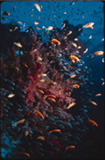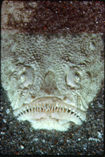





 |
Paul Erickson ’74 delights in offering mind’s-eye impressions of the photographs he’s taken over the years for the New England Aquarium. “The fun of it is what your mind does when you see these things,” he says.”These things” are the living creatures under the Red Sea, where Erickson has photographed on two occasions since he began work with the New England Aquarium in 1975.
For example, ask him to describe the pajama nudibranch, a colorful sea slug pictured at left, and his mind spins: “Definitely something created during the psychedelic sixties of creation week.” Of all the underwater photography he’s done around the world – from Central America and the South Pacific to Loch Ness and tiny New England ponds – Erickson’s experiences diving in the Red Sea are among his most treasured.
“What we’re doing at the Aquarium now is promoting the idea of biodiversity – the diversity of life,” Erickson said. “When I talk about biodiversity, I love to focus on the Red Sea. Surrounding the Red Sea, you’ve got religious factions lobbing bombs at each other, arguing ‘is it your god or my god,’ or in some cases arguing over fragments of religious dogma. Then, sitting in the middle of all these battlefields is an Eden, like the biblical Eden, in the form of the Red Sea.
“When you drive down the Sinai by bus, it’s like a heaven and hell. You stop at places like a former Israeli outpost, where the story is that an Egyptian soldier attached explosives to his body and jumped into one of the bunkers and blew everything up. There are broken gun barrels, rust, and rubble – a representation of hell and fire and cinders that’s still there.
“Then you get to the edge of the Sinai, where all these civilizations and conflicts have taken place, and it’s total peace, you just jump in the Red Sea and you’re there: like taking a plunge into another dimension, sinking into a paradise, the closest to heaven that I can imagine.
“The Red Sea has always struck me that way, as an example of biodiversity that we should try to protect. The Red Sea is a flooded rift valley, basically a crack in the planet that’s flooded, 9,000 feet deep with hydrothermal vents on the bottom. In 200 million years it will be as wide as the Atlantic. Diving in it is more like hang gliding off the World Trade Center or off a cliff, because it’s all vertical and you’re weightless, floating in this crystal-clear water. As you relax, the current can take you past the most beautiful wall of anything you’ve ever seen: like a hanging garden, or Japanese bonsai garden, where soft corals hang down in every color of the rainbow.” |